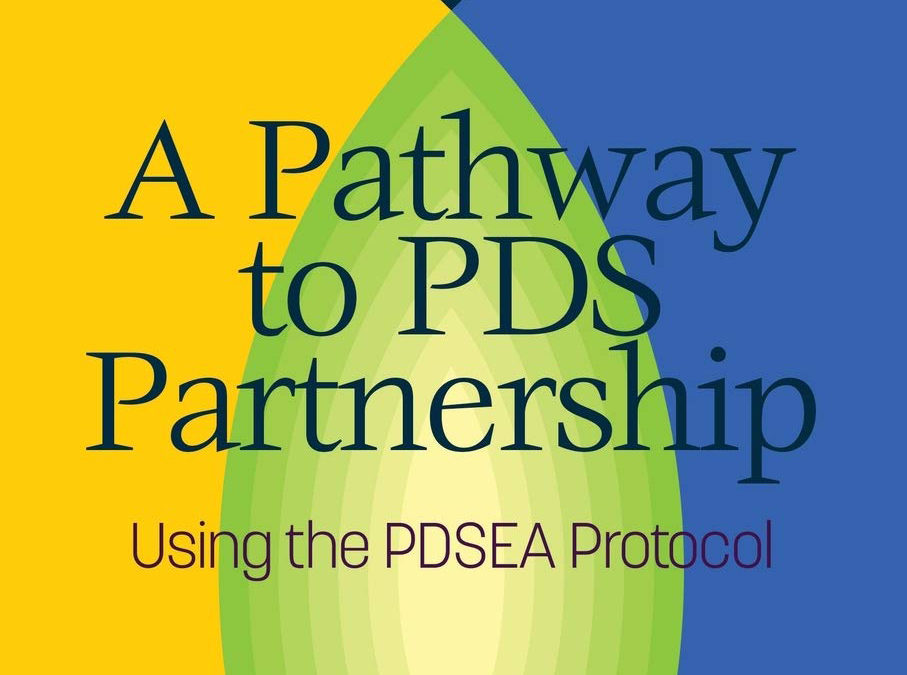Shoemaker, E., Cosenza, M., Kolpin, T., & Allen, J. M. (2020). A Pathway to PDS Partnership: Using the PDSEA Protocol. IAP.
Reviewed by Jennifer K. McCorvey, University of South Florida and Jennifer I. Perez, University of South Florida
Overview
Since The Holmes Group initially introduced the notion of Professional Development Schools (PDSs) over 30 years ago, PDS partnership work has become more abundant nationwide. Those who have ventured into establishing PDSs are well aware of the complexities that exist and the need to continually nurture the relationship. The authors of A Pathway to PDS Partnership: Using the PDSEA Protocol demystify the processes needed to establish and maintain longstanding, mutually-beneficial PDS partnerships.
This work builds on that of early PDS pioneers. In 2003, Teitel’s Professional Development Schools Handbook provided prospective PDS partnership stakeholders the first “how-to” guide, grounded in the NCATE Standards, outlining the critical steps necessary to establish a strong PDS foundation. In 2008, NAPDS further clarified these ideas by publishing What It Means to be a PDS as a guide to “promote a common understanding of what it means to be a PDS” (p.2), resulting in the conception of the 9 Essentials. A Pathway to PDS Partnership: Using the PDSEA Protocol offers a protocol grounded in the 9 Essentials (2008) to assist those developing collaborative partnerships as well as providing a means to evaluate and strengthen existing partnerships. With a focus on stakeholder collaboration and an emphasis on a multidisciplinary approach to developing PDSs, readers can use this protocol to be equipped to initiate and nurture robust partnerships. The authors provide narratives by way of example as well as tools and activities to guide the reader.
The PDSEA Protocol is the product of more than eight years of research involving three universities, and contributions from over 300 PDS partnership participants. As a handbook, the authors provide activities for readers to use to situate themselves with PDS and the PDSEA Protocol. Through gaining an understanding of the Protocol’s components, readers are able to identify their current stage and can begin to conceptualize their next steps. To guide readers, Shoemaker et. al propose an explicit 4-Stage process. These stages are adaptations of the PDSEA Protocol and address the vital questions partners should ask in order to perpetually advance the growth of an existing partnership. They teach about the nature of PDSs, provide guidance in selecting potential partners, determining partnership compatibility, and guide stakeholders in establishing and maintaining a viable, long-standing PDS partnership.
The first part of the book is dedicated to informing readers about what it means to be a PDS and about the PDSEA Protocol. Shoemaker and colleagues begin with emphasizing the importance of providing clinically-rich programs for preservice teachers, and how PDSs meet this need. Focusing on pre-service teachers is often the first step for PDS as it is something already familiar to both P-12 and TTP. Chapters 4-10 will be extremely helpful to these beginning the structure of their PDSs and finding common ground. These chapters guide potential partners through Stages II and III of the PDSEA Protocol. The success of any partnership is dependent upon things such as the alignment between the TPP program and the P-12 environment, the philosophical perspectives of Higher Education and P-12 leadership, and the strengths and needs of both partners, to name a few.
For those who have established partnership compatibility, and are ready to initiate a formal partnership or establish means for continual improvement, Chapters 11 and 12 will be a particularly valuable resource. In Chapter 11, future partners are guided through Stage IV of the PDSEA Protocol by way of seven provided activities. These activities will help establish foundational pillars of a PDS such as a governing committee, a shared mission and shared goals, and the development of a formal Memorandum Of Understanding (MOU). Chapter 12 provides concrete, systematic approaches to moving a SUP partnership through the formalities of PDS to assess the functionality, effectiveness, and sustainability of an existing PDS partnership.
Contribution to Field & Analysis
Research has shown PDSs offer the simultaneous renewal that is necessary for the transformation in our educational system (Goodlad, 1988) but the pathway to achieve a thriving PDS is not always clear. Much has occurred in our field in these past 30+ years which has affected the way we address our partnerships. A Pathway to PDS Partnership: Using the PDSEA Protocol addresses this by expounding upon the idea of collaborative partnerships. It highlights the importance and value of multidisciplinary interactions among P-12 faculty and university faculty. It moves this idea of simultaneous renewal through strong PDS partnerships to practice, by providing a systematic approach to attaining such a renewal. Given the benefit of hindsight, this work updates and fills in the mysteries of PDS structure and process. The book’s aim to simplify the complexities involved in the development and sustainability of PDSs is achieved. The authors generously provide a “one stop shopping” resource for all things PDS — plentiful resources within the book and those that are accessible online as well. We found the online “how-to-guide” a magnificent resource as it allows easy access to the PDSEA Protocol tools.
In Conclusion
This book is a must-read for anyone involved in developing and/or furthering their PDS work. The author’s practical and meaningful tools help PDS stakeholders navigate the complexities of PDS work and ensure that readers will benefit from the insight on how to best engage, maintain, and/or advance PDSs. Those involved in PDS work understand the need for clear direction and will find it in the structure the PDSEA Protocol provides. It is what the field has needed to update our thinking about PDS structure and process.
